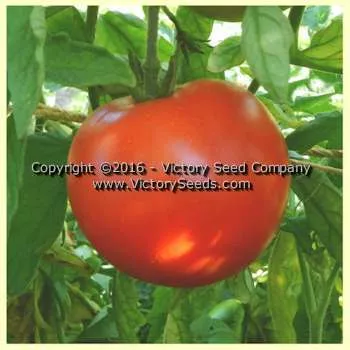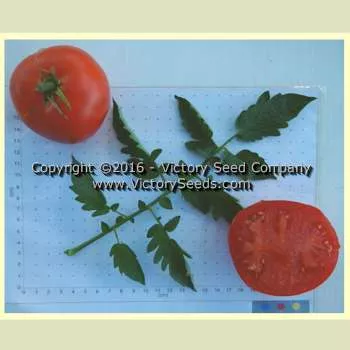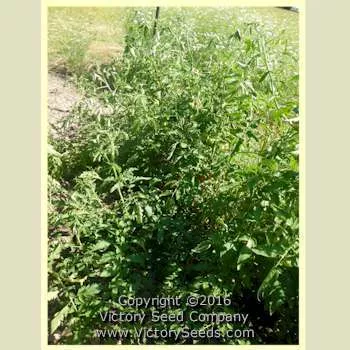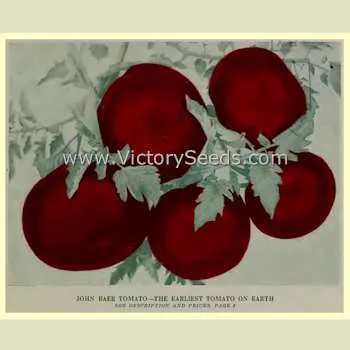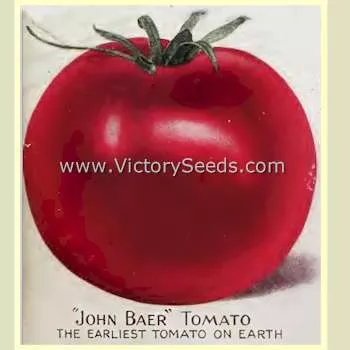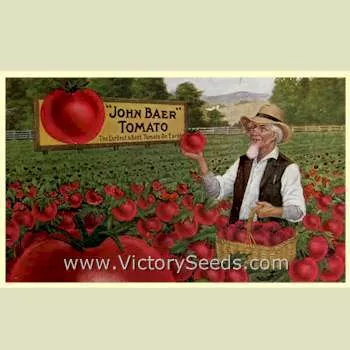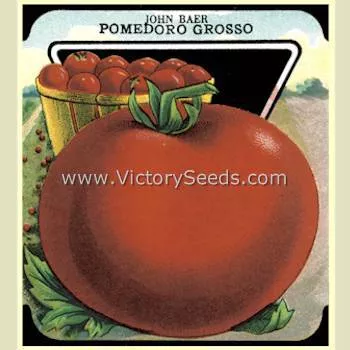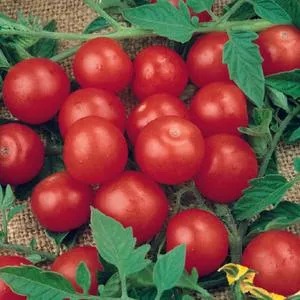







John Baer Tomato
Solanum lycopersicum
Price: $3.45
SKU: 3403721VERY IMPORTANT NOTE: This variety will be available again in early January, 2026. Please signup below to be notified when it becomes available. Click here to learn more about our seasonal products.
75 days, indeterminate - The vines are hardy and very productive. Its fruit are red in color, almost perfectly globe to flattened-globe shaped, range from two to twelve ounces averaging about six ounces each, have smooth skin with firm, solid flesh, and an excellent flavor.
Originating from a single plant of 'Bonny Best', it was developed through fifteen years of selection[4] by market grower and seed producer Mr. John Baer of Baltimore County, Maryland. Having already developed the 'Greater Baltimore' tomato and releasing it through the J. Bolgiano Seed Company of Baltimore, Mr. Baer submitted this variety to Bolgiano who introduced it to the public in 1914 naming it in honor of its creator, 'John Baer'.[1,2]
It became very popular among home gardeners and was quickly added to the seed catalogs of many companies. The Grand Junction Seed Company of Grand Junction, Colorado dedicated a lot of space in their 1919 catalog to espouse all of the reasons why folks should grow the 'John Baer' tomato. They stated:
Originating from a single plant of 'Bonny Best', it was developed through fifteen years of selection[4] by market grower and seed producer Mr. John Baer of Baltimore County, Maryland. Having already developed the 'Greater Baltimore' tomato and releasing it through the J. Bolgiano Seed Company of Baltimore, Mr. Baer submitted this variety to Bolgiano who introduced it to the public in 1914 naming it in honor of its creator, 'John Baer'.[1,2]
It became very popular among home gardeners and was quickly added to the seed catalogs of many companies. The Grand Junction Seed Company of Grand Junction, Colorado dedicated a lot of space in their 1919 catalog to espouse all of the reasons why folks should grow the 'John Baer' tomato. They stated:
"This most wonderful tomato was first introduced by a large Eastern grower in 1914, and the seed was sold at $50.00 per pound. We listed it season before last for the first time, and as we were about the first to introduce it in the West we had some misgivings for fear it might not meet all the wonderful claims the growers made for it.
However, we are glad to say that John Baer has certainly made good, and stands today at the head of the list for an early and best all around tomato. The many good words and letters of recommendation we have received from growers, canners, market gardeners and others justify us in placing it at the head of the list. Our mail orders of this one tomato last season were more than for all the other tomatoes combined."
However, we are glad to say that John Baer has certainly made good, and stands today at the head of the list for an early and best all around tomato. The many good words and letters of recommendation we have received from growers, canners, market gardeners and others justify us in placing it at the head of the list. Our mail orders of this one tomato last season were more than for all the other tomatoes combined."
At one time was a leading canning variety. By the late 1930s, it had become the leading canning variety in New York, Michigan and southeastern Wisconsin where it consistently out-yielded other varieties.[3]
It should be noted that many seed companies list 'John Baer' and 'Bonny Best' as the same variety. This is incorrect. Although very similar due to their close genetic relationship, 'John Baer' is generally earlier to harvest. Our stock was grown out from USDA accession number PI 270192.
Fruit Color: Red
Special Groups: "Epic" Tomatoes
Harvest Timing: Early/Short Season
Genetic Classification: Open Pollinated
Special Groups: "Epic" Tomatoes
Harvest Timing: Early/Short Season
Genetic Classification: Open Pollinated
Sow seeds indoors (do not direct sow into the garden), using sterile seed starting mix, 6 to 8 weeks before your last expected frost date. Plant 1/4" deep, water lightly but keep moist until emergence.
Full light and cooler temps (60° to 70°) will help to prevent the seedlings from becoming too leggy. If plants become rootbound before you can safely set them into the ground, transplant them into larger pots.
Harden off plants before planting outside. Young plants are very susceptible to frost and sunburn damage. Avoid too much nitrogen. Water evenly but not in excess.
Click here to view our full tomato growing guide.
Full light and cooler temps (60° to 70°) will help to prevent the seedlings from becoming too leggy. If plants become rootbound before you can safely set them into the ground, transplant them into larger pots.
Harden off plants before planting outside. Young plants are very susceptible to frost and sunburn damage. Avoid too much nitrogen. Water evenly but not in excess.
Click here to view our full tomato growing guide.
References:
- "The Pedigree of Varieties of Lycopersicon Esculentum Mill.," G. A. Kemp, Canada Department of Agriculture, Lethbridge, Alberta, April 20, 1960.
- "Yearbook of Agriculture," USDA, 1937.
- "Tomato Varieties," by Gordon Morrison, Michigan State College A.E.S., Special Bulletin 290, April 1938.
- J. Bolgiano & Son Seed Company, Baltimore, Maryland, 1914 Seed Annual.
Customer Reviews:
Do you have experience with this one? 📝 📣 Write a review!
★★★★★ Family heritage tomato
By Dorothy Bowen (Placitas, NM) on October 6, 2025
By Dorothy Bowen (Placitas, NM) on October 6, 2025
I would love some seeds when they are back in stock. My grandfather's family, German immigrants, lived in Baltimore… his mother was a Baer. I was told that one of the Baers developed a famous tomato… this must be it!

